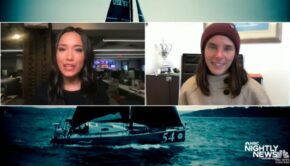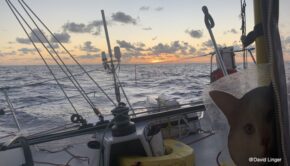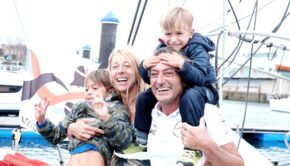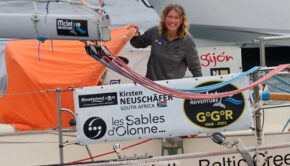Five ‘Vendée Globe’ races for the poor
Published on March 8th, 2021
Held every four years, the Vendée Globe is the greatest challenge in offshore racing. Just getting to the start line is an epic feat, and acquiring the skill to master the 60-foot IMOCA boat while attaining the funds to skipper it is a hurdle that gets higher with each edition.
The Vendée Globe requires a highly professional approach which has opened the door for five race concepts to serve the medium level professional to amateur sailors. Paulo Pernão of Interesting Sailboats describes the options:
THE RACE AROUND – 2023
Regarding the proposed circumnavigation races done in smaller than 60ft sailboats, this is the one with higher sportive interest. It will be raced on Class40 sailboats and it is also the one that has higher security requirements, which are expressed on the boat safety requirements, mandatory equipment, the qualification requirements, and on the racecourse.
Today almost all circumnavigation races, solo, duo, or crewed, are done in IMOCA, the 60ft class that earned the right to be considered the most suitable yacht to perform them, the one that reunites the seaworthiness and speed to make them not only safe but competitive and interesting.
But an IMOCA is an expensive yacht, not too expensive for a top-sailor, but out of reach for dozens of competitive professional sailors, that have not yet reached the top level, not to mention hundreds of high-level semi-professionals and top amateurs.
Class40, the solo/duo class below the IMOCA class, would be the obvious choice to consider for a circumnavigation race on a smaller and less expensive yacht. But they have not the same seaworthiness and it would not be safe to race them on the Vendée Globe racecourse, at high latitudes.
If it were safe the Vendée Globe would have two classes, one for IMOCAs and another for Class40, like it happens on almost all professional solo and duo racing Transats. But that is not the case on the Vendée, and for that reason was not ever even considered.
For having a circumnavigation race on Class40 racers, with approximately the same level of safety as the Vendée, another racecourse would have to be chosen, one without so much high latitude racing and the best way to manage that is to make it a race with several legs.
A race with several legs will also be easier in what regards the physical and psychological sailor demands, will allow small repairs on the boats and will make it possible the postponement of a leg start, if very nasty and unusual weather is forecasted, as a way to avoid it.
The choice of a duo race instead of a solo one has probably to do not only with making it easier, in what regards sailing, but also in what regards finding a budget, dividing the costs by two. However, if the number of entries is big enough I do not see any problem in having two classes, one for solo, other for a duo, even if previous experiences have shown that it is very difficult to find an acceptable number of racers for a Class40 circumnavigation race.
There was already a similar Class40 circumnavigation race, the “Global Ocean Race”, that had very limited success and died at the end of two editions, not because the idea was not interesting, but because, due to lack of public interest (and sponsoring), the number of racers was too small.
On the Global Ocean Race first edition (2008/09) only 4 boats finished, the same number that finished on the 2nd and last edition, in 2011/12, but from those 8 sailors, two are today medium or top solo professional sailors and both have made the Vendee Globe, one being near to winning it on the last edition (Boris Herrmann). The other one is the NZ/American Conrad Colman. Quite a ratio that shows this race can be an excellent school for growing, as ocean professional solo racers.
“The Race Around” has the sponsorship from the official Class40 organization and is the one that is pointed to Class40 racers on competitive boats, meaning for the ones that race the Class40 championship, not for the ones that without previous racing experience would buy an outdated old Class40, just to do this race.
The boats will comply with the safety requirements of Category 0 (the higher of World Sailing Federation), the race will have four or five legs and it will start in France finishing in Portugal.
The Race Around was announced in 2019, but since then few developments have happened: no list of entries and the site has not even a French page, and knowing that most Class40 racers are either French or live in France, it is a very bad sign and it may indicate that a truly competitive circumnavigation on Class40, with many top boats and top sailors, is still very much a dream, a nice dream though.
The biggest problem with this race is the needed budget, that although it is not big for a circumnavigation race, it is necessarily considerable and not at the reach of young sailors that are trying to continue their solo or duo professional sail career, unless they can raise the budget through sponsoring and that’s where you can help because sponsors are only interested in the races that raise a big public interest, and therefore will bring them good publicity and revenues.
So if you think that this can be a great race, as I do, share this post, “like” their Facebook page and “like” their promo videos.
This way you are helping not only in making this race big, but also helping all those young racers that are trying to find sponsors. If things continue like before I would say that this race, as a big event, is doomed. And that it is a pity because it could be great fun and a spectacular race. Maybe the big success of the last Vendée will help to boost this race.
Details: https://www.theracearound.com/
GLOBE 40
The Globe 40, is also a duo Class40 circumnavigation, previewed to start in 2021, but postponed due to COVID to 2022. This postponement has had as consequence the retirement of Class40 sponsorship. The race was taken out of their calendar due to the coincidence in time with the Route du Rhum, a Transat that is the biggest and more prestigious race on the Class40 calendar.
This means that top Class40 racers will not be racing it, and this re-oriented the race, which now does not point anymore to professionals and semi-amateurs with considerable racing experience in the class. The race is pointed now to good level amateurs and the boats used will be mostly older, non-competitive at the top level, Class40.
Older non-competitive Class40 racers are much cheaper, there are many of them and that can make it easier to find a budget, especially if we consider that on this race the crew is not a fixed one and can be changed in each race leg. This allows for a lower-cost circumnavigation race, allowing more sailors to share the budget costs.
Changing the crew at each stop-over, with the sole limitation of one of them having already sailed a leg, will allow a team of 6 sailors to do the race, alternating in each leg. It is detrimental for the sportive relevance of the race but it is understandable in what regards allowing amateurs to have the time and the budget to participate in the event.
A race pointed to serious amateurs and semi-professionals that want to have fun doing a circumnavigation race on an outdated but less expensive, Class40 race boat. The race will have 7 legs, starting in Tangier (26 June 2022) and finishing, 30,000 miles after (140days), in Lisbon (March 2023). The legs for the front runners will be spread over 12 to 24 days.
The chosen stop-overs and legs give the warranty of not sailing at very high-latitudes, being the only exception the Cape Horn, which will be crossed on a leg that starts in Papeete and finishes in Ushuaia. Due to the different performances of older and newer Class40, it is previewed to divide the boats according to their generation, allowing for several classes with separate classifications.
There are already 19 entries that surprisingly include some top professional solo sailors, namely the French Kito de Pavant (IMOCA and Figaro racer) that sails with Gwen Gbick, a medium-class Figaro racer and the Spanish Guillermo Altadill, (IMOCA and VOR), teaming with the Portuguese Felipe Silva, a Finn top sailor.
Details: https://www.sailingscuttlebutt.com/2019/06/11/global-doublehanded-race-in-class40s/
GLOBAL SOLO CHALLENGE
The Global Solo Challenge will start in 2023 and will finish in 2024. This race wants to be even more “popular” and cheaper than the Globe 40 and to make the boats “cheaper” only boats older than 18 years will be accepted (prior to 2005), and they have to be production boats with 20 built units. They cannot have less than 35ft and no more than 40ft, nor less than 5500kg, a IRC rating below 1.25, and a D/LOA(?) between 150 and 250.
Taking a better look at the rules we can see that all this is all “more or less” (~), that they say specifically that regarding the 20 production units it is only “preferably”, that regarding displacement and D/LOA, it “may vary from some designs” and they say quite clearly ” boats not meeting the above criteria may still apply and may be accepted at the sole discretion of the Event Organizers”. This “more or less” attitude has little to do with serious racing, where precision on the rules is the essence.
And the “more or less” thing continues in what regards safety requirements: They begin considering the World Sailing Federation safety requirements for “Monohull Category Zero”, the ones that according to the world sail federation are adequate for Ocean racing (not specifically for racing in high latitudes) but because probably most of the entries would be excluded, without costly alterations or inspections, they “reviewed and simplified” the rules, and we can see that a lot of those requirements are excluded.
But it seems that the safety rules that remained were still too much in what regards mandatory safety requirements and they ended up considering that those requirements are only “recommendations ” and that “each boat should try to adhere as closely as possible to the recommendations set out below treating them as far as possible as requirements”, and they end up with this more than ambiguous statement: “Compliance with the GSC Regulations issued by the organizers does not in any way constitute an indication of the suitability of a boat or skipper to take part in the event…”
Further confusion follows when we look at the list they propose as suitable boats, many with more than 40ft, some much bigger, or obviously completely out of the established acceptance criteria, with the following note: “Boats followed by “Please enquire” do not meet all parameters and … they are more likely to be accepted for boat owners wishing to enter the event with the boat they already have.”
They consider that this “race” as a “single-handed one, non-stop and without assistance at sea” but as in what regards the boats’ requirements there are exceptions, and the sailors can go to any port for repairs (with a penalty), outside routing is permitted, as well as the use of the engine for propulsion.
Due to the huge variety of accepted boats, the race start will vary greatly for the 6 previewed categories and will extend for almost 2 months from September 2 to October 28.
The course will be “an around the world east-about circumnavigation, the start and finish ports will be on the Eastern side of the North Atlantic and entrants must leave “The Antarctic Region” to starboard and the three Great Capes to port before making their way to the finish line. “The Antarctic Region” will be defined in the Sailing Instructions.”
And even if everybody talks about this as a sailing race, it is not. It is a sailing event, where the engine will be free to be used.
The main reason for this to be an event, and not a race, lies in the many shortcuts that are made regarding safety rules (regarding boats and equipment), that are mandatory in any offshore race hosted by a sailing club and under the World Sailing federation. The free use of the engine, by itself, is a motive for exclusion as a sailing race.
What seemed to be a good idea turned into a “race” outlawed by the world sail federation to the point of having to be called an event. Sailing non-stop circumnavigation race in different types of sailboats seems a good idea, but the bad ideas are so many that it is difficult to know where to start:
From the relativization of the rules (and exceptions) to determine which boats can enter to the huge differentiation in what regards acceptable boat performance (anything below more or less 1.25), passing by the prohibition of designs after (more or less) 2005, to the noncompliance with World Sailing Federation safety rules for Ocean racing, to the use of the engine for propulsion, the lousy ideas are so many that it is difficult to name them all.
Another two bad ideas are the aleatory choice of boats that according to the organization can enter the “event”, many of them not complying with the “notice of event” and the choice to have course starboard to the three Great capes, excluding the Antarctic region. Such a course, due to the latitude of Cape Horn and whatever definition is given for the Antarctic Region, will necessarily imply racing at high-latitudes.
The Antarctic Ocean is generally defined as below 60º south latitude (cape Horn 55°56′ South) but even if we consider the Southern Point of New Zealand latitude (47º 17′ South) we are already talking about sailing at near 50º South latitude and that means not only sailing on the “Roaring forties” but also on the “Furious fifties”.
Most of the sailboats that are “suggested or accepted” by the organization (some of them on the photos) are not designed to sail on high-latitudes, much less to race safely at those latitudes.
It is a serious case of hypocrisy to suggest those boats as fit to enter the event while saying on the notice that their choice “does not in any way constitute an indication of the suitability of a boat or skipper to take part in the event”.
Regarding the limitation to boats designed previously to 2005, what can be seen as a way to lower costs and a good idea, has in fact very pernicious effects in what regards safety. Any insurance company will charge much more to insure a 20-year-old boat than a new one, and many try to avoid insuring them at all and there is a reason for that. A modern designed 15-year-old boat has already a need for serious and costly inspections and replacements.
From the rig to the keel, passing by chain plates, through the hull valves and rudder, all have to be inspected, many things replaced and even more for a boat entering an event like this sailed at many hundreds of miles from land on very cold waters.
Considering boats with more than 15 years, proof of inspection of the keel bolts (that can be made only by dropping the keel) should be made since there is no way to verify that any other way, as well as proof of detailed boat structure inspection.
All this contributes to making a choice of an older boat expensive if safety requirements are met, but the rules exempt these boats from inspections that are even mandatory for “Monohull Category Zero”, a class that is meant for Ocean racing but not specifically designed for boats racing at high latitudes. This will increase substantially the risks.
It could have been a very interesting circumnavigation race for IRC/ORC yachts, if safety measures, size, and seaworthiness of the sailboats were adequate for racing in high-latitudes, and there was a narrower difference in performance between the sailboats (for instance only IRC Class 4 and 5).
As it is, it is not even a race but an “event”, open to boats with completely different performances and not an event where the safety risk is at the level that World Sailing Federation deems to be reasonable, not even for an Ocean race, much less for a high-latitude solo race. It is an adventure and it is for each one to take the risks one seems fit, with his own life.
Other questions are the risks and costs that will be taken by the ones that will undertake the rescues that the high risk of the event makes predictable. But that, as in many other activities that involve considerable risk, can be dealt with with mandatory covering insurance, even if it is not the case here (but should be).
Regarding participation in the “event”, a minimum passage of 2000 nautical miles single-handed on the boat entered in the event is required, but as usual in this “event”, there are exceptions, and “any other circumstance must be submitted to the organizers for consideration”.
Details: https://globalsolochallenge.com/
GOLDEN GLOBE RACE
This race is well known by all, due to the media success of the first edition. The second edition will start in 2022, 4th September. It is a retro solo circumnavigation race, without assistance, without GPS, external routing, without AIS, radar, or any “normal” navigation aids. The autopilot will have to be a wind-vane and the boats have to have been designed more than 33 years ago, part of an approved list, and in between 32 and 36ft.
It was supposed to show that on equal conditions and without electronic aids good sailors were as good as Vendee racers, but a septuagenary, an ex-vendee professional racer, won the race sailing with an ocean of advantage over the 2nd, a young adventurer at the top of his skills.
The competitive interest was nil and only on the last part, when the old ex-professional solo racer, had to sail slower, due to big damage on the mast, some interest was raised in knowing if the younger amateur could reduce the distance due to the problems on the old man’s boat.
On the first edition of this retro race (2018), the retirement rate was huge and only 29% finished it. Among the 17 boats three retired very early (Canary Islands) and from the 14 that continued two suffered very serious accidents that only by luck have not resulted in serious consequences for the sailors: one boat was pitch-poled and another one was rolled, both having broken the masts being one of them swamped. Besides those, three more boats lost the mast (five in all) and three abandoned it due to a broken wind vane.
In the first edition, navigating without GPS was not what happened, because the racers knew, from time to time, their position due to the tracker and long-range radio contacts, impossible to detect or to follow. They have only access to “old” weather forecasts received through radio or weatherfax, plus the “illegal” information or routing furnished by long or medium wave radio provided by radio amateurs that follow the race.
The Golden Globe “race” is also conducted out of the Sailing Race Federation (World Sailing) and their safety requirements. It is hosted by an odd sail club sponsored by the organization, the Royal Nomuka Yacht Club in the Kingdom of Tonga.
There are already many sailors interested and given as provisional entries, much more sailors than there were in 2018, being 35 the max number of entries.
The entries should have at least 8000 miles of ocean sailing experience, as crew or skipper, and 2000 nautical miles solo, non-stop ocean miles on the yacht that will enter the race, according to a previously delivered sail plan…. that without GPS or AIS will be impossible to check.
What I said regarding the Global Solo Challenge, in what concerns excessive risks is also true here, and that is the reason why this race is not hosted by any credible sail federation and subjected to the World Sailing safety requirements, in what regards ocean racing. The risks are increased by the absence of AIS or radar and that, for a solo sailor, increases collision risks greatly.
With 35 entries, if the 2018 serious accident average is considered, we will have 4 boats rolled or pitch-poled, 10 broken masts with only 10 boats managing to finish the race. As I said before, each one knows the risks that one finds acceptable, but this is much more an adventure than a sailing race.
Maybe we will see some old retired French professional sailors doing it, just for fun and in this case, maybe we will have some sort of geriatric high-level competition that will leave all the amateurs behind. Anyway, that kind of competition goes well with the retro aspect of the race and can be great fun, making all of us older than 60 feeling a lot younger.
Details: https://www.sailingscuttlebutt.com/tag/golden-globe/
MINI GLOBE RACE
The Mini Globe Race is previewed for 2024 and contrary to what the name implies it is not raced on what is known as mini racers (6.50m) but on a smaller and less seaworthy sailboat, a one-class boat, home built, with 5.80m.
The 5.80 seems well designed, even if dated, and the building process makes sense. Several similar boats have been built by the designer and some have crossed the Atlantic at the right season.
The racing circumnavigation will not be by the “normal route”, leaving to the North the three capes, but one that will not be raced at latitudes higher than 40º. It will be a solo race without modern instruments but not a non-stop race, crossing the Panama canal and having 6 legs.
For entering a sailor has to have 2000 miles of Ocean experience (crewed or not) and 750 miles of Ocean experience sailing solo on the 5.80 and in the racing configuration. It seems that it is also mandatory for a coastal race to take place in the summer of 2022 along the Portuguese West Coast.
Other solo Ocean races are previewed for the 5.80 before the circumnavigation, namely two Transats (November 2021 and 2023).
I have posted before about this proposed class and this circumnavigation race (click here). Many have contacted me for more information regarding what I thought about this sailboat, and the post comments are interesting and complement the post.
And the truth is that I find this sailboat interesting, as a means to have a reasonably well designed cheap and strong boat for coastal cruising, with some offshore ability but I don’t find it an adequate boat to do Ocean passages and even less to do a circumnavigation.
By this, I don’t mean that it is not possible to do navigation on this boat, much less an Ocean passage. What I mean is if there will be 20 boats doing this circumnavigating race several will be capsized, some rolled or pitch-polled, some swamped and some will manage to finish the race.
What I mean is that the risks are just too big for accepting this as a sportive event and that is why, to this boat, in many countries, will not be given a permit to do bluewater sailing, and will be illegal to do so on it. In those countries, it is only allowed to do Ocean sailing on a class A certified sailboat, and there is no way this boat could pass the certification requirements for a class A sailboat.
For the Mini Transat to be raced legally (on 6.50 mini racers) under the supervision of the French Sailing Federation, the race has to be accompanied by several support boats that will be ready for assistance if needed, and the 6.50 minis are more seaworthy sailboats, with a lot more stability than the 5.80 mini (see the article with link above).
Like the two previous events, much more an adventure (and a bigger one) than a sportive event. To each one to decide what risks to take, even if they are unreasonable high for a sportive event. If what you want to do is Ocean competitive solo sailing, buy an old 6.50 mini racer, make it seaworthy again and do the Mini-Transat. This event is a completely different thing and pointed to different sailors.
If what you want is a huge and risky sail adventure, then the 5.80 circumnavigation “race” may suit you….but in what regards performance sportive achievement winning (or even arriving between the 10 first) on the Mini-Transat will be much more meaningful than winning this circumnavigation.
On the Mini-Transat you will have as participants almost all youngsters that dream one day to become top professional solo racers (some have been working to achieve that for already several years and have done several Transats) while on the 5.80 circumnavigation you will have relatively inexperienced sailors (in solo racing), mostly adventurers that dream doing a circumnavigation-race.
Details: https://www.sailingscuttlebutt.com/tag/class-globe-5-80/









 We’ll keep your information safe.
We’ll keep your information safe.